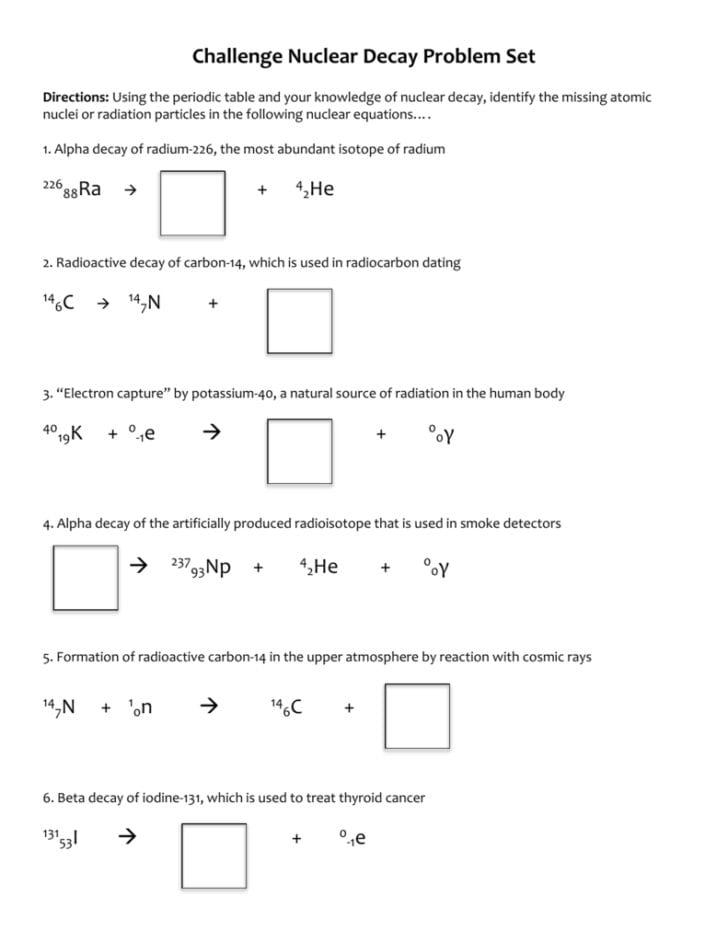42 nuclear decay worksheet answers chemistry
Le Chatelier's Principle & pH | Overview, Impact & Examples - Video ... Go to Nuclear Chemistry & Radioactive Decay: Help and Review Ch 9. ... Accuracy vs. Precision in Chemistry; Quiz & Worksheet - Inverse Trigonometric Function Problems ... Questions & Answers ... 3.7: Conservation of Mass - Chemistry LibreTexts Solution Mass of the reactants = Mass of the products 10.0 g of CaCO 3 = 4.4 g of CO 2 + 5.6 g of CaO 10.0 g of reactant = 10.0 g of products Because the mass of the reactant is equal to the mass of the products, the observations are in agreement with the law of conservation of mass. Exercise 3.7. 1
DP Chemistry: SL Questions on each sub-topic - ThinkIB SL Questions on each sub-topic. I strongly recommend that you sign your students up to student access. This is so they can get access to all the material in Complete course for students, which is the part of this site written specifically for students (although you have full access too), and covers everything they need during the course and to ...

Nuclear decay worksheet answers chemistry
Radiation - Quantities and Units of Ionizing Radiation : OSH Answers Radioactive decay is the decline in radiation intensity. Half-life is the time after which the radiation intensity is reduced by half. This happens because half of the radioactive atoms will have decayed in one half-life period. For example a 50 Bq radioactive source will become a 25 Bq radioactive source after one half-life. M & M Decay - Teaching Activities This is a simulation of radioactive decay which illustrates what a half-life is and explains some of the challenges involved with radiometric dating. Pennies or other cheap coins can be substituted for M&Ms if needed. ... The class has a debriefing after finishing the worksheet. Each group of students presents its answer to one or two of the ... Rare-earth element - Wikipedia The rare-earth elements (REE), also called the rare-earth metals or (in context) rare-earth oxides, or the lanthanides (though yttrium and scandium are usually included as rare-earths) are a set of 17 nearly-indistinguishable lustrous silvery-white soft heavy metals. Scandium and yttrium are considered rare-earth elements because they tend to occur in the same ore deposits as the lanthanides ...
Nuclear decay worksheet answers chemistry. KEAM 2022 Exam - Dates, Result, Cut Off, Counselling, Admit Card ... Radioactivity-alpha, beta, and gamma particles/rays and their properties; radioactive decay law: Mass-energy relation, mass defect; binding energy per nucleon and its variation with mass number; nuclear fission and fusion: ... Steps to download KEAM answer key 2022. Visit the KEAM official website at cee.kerala.gov.in; Nature First published in 1869, Nature is the world's leading multidisciplinary science journal. Nature publishes the finest peer-reviewed research that drives ground-breaking discovery, and is read by ... Learning and Teaching Resources: Geography - Education Bureau Learning and Teaching Resources on Guangdong-Hong Kong-Macao Greater Bay Area (Greater Bay Area) This learning and teaching resource package was developed by Dr CHENG Nga-yee Irene, Dr CHEUNG Ting-on Lewis, Dr Chow Sin-yin Alice and Dr FOK Lincoin of the Education University of Hong Kong and is intended for teachers' reference and does not represent the point of view of the Education Bureau. Geologic time scale - Wikipedia The geologic time scale, or geological time scale, (GTS) is a representation of time based on the rock record of Earth.It is a system of chronological dating that uses chronostratigraphy (the process of relating strata to time) and geochronology (scientific branch of geology that aims to determine the age of rocks). It is used primarily by Earth scientists (including geologists ...
Décorez votre espace avec des idées de décoration intérieure Recherchez des idées de maison et de décoration intérieure ! Parcourez les images de la maison pour vous inspirer de la décoration intérieure. Trouvez des professionnels de la maison et de beaux articles pour la maison. Emergency Showers and Eyewash Stations : OSH Answers 15-20 minutes for moderate to severe irritants and chemicals that cause acute toxicity if absorbed through the skin, 30 minutes for most corrosives, and 60 minutes for strong alkalis (e.g., sodium, potassium or calcium hydroxide). In all cases, if irritation persists, repeat the flushing procedure. Examples of Physical Changes and Chemical Changes Signs of a chemical change include the following: Gas is produced. In liquids, bubbles may form. An odor is produced. The substance changes color. Sound is produced. There is a temperature change. The surroundings become either hot or cold. Light is produced. A precipitate forms. The change is difficult or possible to reverse. Resources | IUCN Our resources share the knowledge gathered by IUCN's unique global community of 18,000+ experts. They include databases, tools, standards, guidelines and policy recommendations. We author hundreds of books, assessments, reports, briefs and research papers every year. Search all resources.
Which Type of Radiation Is the Most Penetrating? If you're wondering which type of radiation is the most penetrating, the answer depends on what types of radiation you're including and the nature of the matter. Gamma rays are the most penetrating type of common radiation from radioactive decay. Lead shielding blocks gamma radiation. X-rays are similarly penetrating. Protons Neutrons And Electrons Middle School Chemistry The answer is well beyond an introduction to chemistry for middle school, but one thing you can say is that there is a force called the "Strong Force," which holds protons and neutrons together in the nucleus of the atom. This force is much stronger than the force of repulsion of one proton from another.. Curiosity rover: The ultimate guide | Space About 60 feet (18 m) above the surface, MSL's "sky crane" deployed. The landing assembly dangled the rover below the rockets using a 20-foot (6 m) tether. Falling at 1.5 mph (2.4 kph), MSL gently... Ionization Energy - Chemistry LibreTexts Answers 1) Element D, 2) D, 3) B, 4) A, 5) B, 6) B, 7) C, 8) C, 9) A 10) Gallium has one electron in the 4p orbital, which can be expelled to reveal a more stable and full 4s orbital. Calcium, however, has a fully stable 4s orbital as its valence orbital, which you would have to disrupt to take an electron away from. References
InThinking DP Chemistry This has been a survival guide and good inspiration for lessons. Magdalena Tsavkova, Vienna International School, Austria. Easy, user friendly site that enables the teachers to easily access to a wealth of materials, questions, TOK, nature of science and exam uestions.
MyUCLA Asian American Studies Center to create free resource for high school teachers. Bringing a physicist's mindset to the biosciences. COVID expert Dr. Otto Yang's moonlight hobby. Dr. Gil Hoftman honored with career development award.
MCSM Regents Chemistry || Unit #1: Matter & Energy - NYLearns 2. Defining Matter and Density. Chemistry is the study of matter and the changes it undergoes. Particle nature of matter means that properties of matter depend on the particles that make up matter. Matter occupies space (volume) and has mass. The relationship between mass and volume is referred to as "density".
Conceptual Physical Science Explorations 16.5 Half-Life Is a Measure of Radioactive Decay Rate; 16.6 Isotopic Dating Measures the Ages of Materials; 16.7 Nuclear Fission'The breaking Apart of Atomoic Nuclei; 16.8 The Mass-Energy Relationship: E = mc2; 16.9 Nuclear Fusion—The Combining of Atomic Nuclei; Chapter 17: Elements of Chemistry. 17.1 Chemistry is Known as the Central Science
Rare-earth element - Wikipedia The rare-earth elements (REE), also called the rare-earth metals or (in context) rare-earth oxides, or the lanthanides (though yttrium and scandium are usually included as rare-earths) are a set of 17 nearly-indistinguishable lustrous silvery-white soft heavy metals. Scandium and yttrium are considered rare-earth elements because they tend to occur in the same ore deposits as the lanthanides ...
M & M Decay - Teaching Activities This is a simulation of radioactive decay which illustrates what a half-life is and explains some of the challenges involved with radiometric dating. Pennies or other cheap coins can be substituted for M&Ms if needed. ... The class has a debriefing after finishing the worksheet. Each group of students presents its answer to one or two of the ...
Radiation - Quantities and Units of Ionizing Radiation : OSH Answers Radioactive decay is the decline in radiation intensity. Half-life is the time after which the radiation intensity is reduced by half. This happens because half of the radioactive atoms will have decayed in one half-life period. For example a 50 Bq radioactive source will become a 25 Bq radioactive source after one half-life.












0 Response to "42 nuclear decay worksheet answers chemistry"
Post a Comment